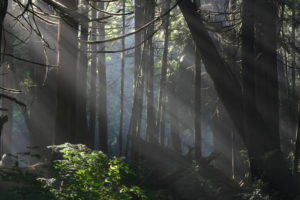A vivid setting makes your fiction more believable. It can also build the mood of your story, creating, mystery, suspense and even conflict.
You can create vivid settings with some hard work and diligent attention to detail. Let’s try building a memorable setting ourselves. We’ll start with a simple setting and see if we can bring it to life.
There was a path through the trees and into some bushes.
Now let’s be more specific:
There was a path through the trees and into a clump of bracken and spruce.
Let’s create action, even in the inanimate:
A path wound among the trees and into a clump of bracken and spruce.
We’ll add adjectives that convey mood:
A path of matted pine needles wound among the trees and into a shadowy clump of bracken and snow-laden spruce.
Let’s explore the other senses:
A path of matted pine needles wound among the trees and into a shadowy clump of bracken and snow-laden spruce. An icy wind carried the sharp tang of pine and the damp decay of the forest floor.
Add the potential for change over time:
A path of matted pine needles wound among the trees and into a shadowy clump of bracken and snow-laden spruce. An icy wind carried the sharp tang of pine and the damp decay of the forest floor. The swaying of the tallest pines indicated a change in the weather and more snow to come.
Use active verbs:
A path of matted pine needles wound among the trees. Fifty feet into the forest it disappeared into a shadowy clump of bracken and snow-laden spruce. An icy wind carried the sharp tang of pine and the damp decay of the forest floor. The tops of the tallest pines whispered of a change in the weather and more snow to come.
Finally, place your protagonist in the scene, and show it through his or her senses:
From her vantage at the edge of the forest, she could see the path of matted pine needles winding among the trees. Fifty feet in, it disappeared into a shadowy clump of bracken and snow-laden spruce. The icy wind reddened her cheeks, carrying the sharp tang of pine and something earthy, maybe the damp decay of the forest floor. High above, the wind swayed the tops of the tallest pines, whispering of a change in the weather and more snow to come.
See how the setting itself has became an active part of the story, creating a sense of impending change? Now you try it with your own setting. Follow these steps:
- Start with a simple setting.
- Be more specific.
- Create action, even in the inanimate.
- Add adjectives that convey mood.
- Explore the other senses.
- Add the potential for change over time.
- Use active verbs.
Finally, place your protagonist in the scene, and show it through his or her senses.
To learn more about settings, enroll in one of our writing workshops at http://writingacademy.com. Or subscribe to all of our classes for an amazing monthly bargain!

